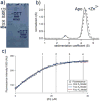De Novo Design of an Allosteric Metalloprotein Assembly with Strained Disulfide Bonds
- PMID: 27649076
- PMCID: PMC5085265
- DOI: 10.1021/jacs.6b08458
De Novo Design of an Allosteric Metalloprotein Assembly with Strained Disulfide Bonds
Abstract
A major goal in metalloprotein design is to build protein scaffolds from scratch that allow precise control over metal coordination. A particular challenge in this regard is the construction of allosteric systems in which metal coordination equilibria are coupled to other chemical events that take place elsewhere in the protein scaffold. We previously developed a metal-templated self-assembly strategy (MeTIR) to build supramolecular protein complexes with tailorable interfaces from monomeric building blocks. Here, using this strategy, we have incorporated multiple disulfide bonds into the interfaces of a Zn-templated cytochrome cb562 assembly in order to create mechanical strain on the quaternary structural level. Structural and biophysical analyses indicate that this strain leads to an allosteric system in which Zn2+ binding and dissociation are remotely coupled to the formation and breakage of a disulfide bond over a distance of >14 Å. The breakage of this strained bond upon Zn2+ dissociation occurs in the absence of any reductants, apparently through a hydrolytic mechanism that generates a sulfenic acid/thiol pair.
Figures



Similar articles
-
Determining the Structural and Energetic Basis of Allostery in a De Novo Designed Metalloprotein Assembly.J Am Chem Soc. 2018 Aug 8;140(31):10043-10053. doi: 10.1021/jacs.8b05812. Epub 2018 Jul 25. J Am Chem Soc. 2018. PMID: 29996654 Free PMC article.
-
Design and Construction of Functional Supramolecular Metalloprotein Assemblies.Acc Chem Res. 2019 Feb 19;52(2):345-355. doi: 10.1021/acs.accounts.8b00617. Epub 2019 Jan 30. Acc Chem Res. 2019. PMID: 30698941
-
Metal-Directed Design of Supramolecular Protein Assemblies.Methods Enzymol. 2016;580:223-50. doi: 10.1016/bs.mie.2016.05.009. Epub 2016 Jun 24. Methods Enzymol. 2016. PMID: 27586336 Free PMC article.
-
Control of mature protein function by allosteric disulfide bonds.Antioxid Redox Signal. 2011 Jan 1;14(1):113-26. doi: 10.1089/ars.2010.3620. Epub 2010 Oct 28. Antioxid Redox Signal. 2011. PMID: 20831445 Review.
-
Artificial metalloenzymes derived from three-helix bundles.Curr Opin Chem Biol. 2015 Apr;25:65-70. doi: 10.1016/j.cbpa.2014.12.034. Epub 2015 Jan 8. Curr Opin Chem Biol. 2015. PMID: 25579452 Free PMC article. Review.
Cited by
-
Structural analysis of a ligand-triggered intermolecular disulfide switch in a major latex protein from opium poppy.Acta Crystallogr D Struct Biol. 2024 Sep 1;80(Pt 9):675-685. doi: 10.1107/S2059798324007733. Epub 2024 Aug 29. Acta Crystallogr D Struct Biol. 2024. PMID: 39207895 Free PMC article.
-
Metal-Templated Design of Chemically Switchable Protein Assemblies with High-Affinity Coordination Sites.Angew Chem Int Ed Engl. 2020 Dec 1;59(49):21940-21944. doi: 10.1002/anie.202009226. Epub 2020 Sep 28. Angew Chem Int Ed Engl. 2020. PMID: 32830423 Free PMC article.
-
Rigidifying a De Novo Enzyme Increases Activity and Induces a Negative Activation Heat Capacity.ACS Catal. 2021 Sep 17;11(18):11532-11541. doi: 10.1021/acscatal.1c01776. Epub 2021 Sep 1. ACS Catal. 2021. PMID: 34557328 Free PMC article.
-
Engineering protein assemblies with allosteric control via monomer fold-switching.Nat Commun. 2019 Dec 13;10(1):5703. doi: 10.1038/s41467-019-13686-1. Nat Commun. 2019. PMID: 31836707 Free PMC article.
-
Confirmation of intersubunit connectivity and topology of designed protein complexes by native MS.Proc Natl Acad Sci U S A. 2018 Feb 6;115(6):1268-1273. doi: 10.1073/pnas.1713646115. Epub 2018 Jan 19. Proc Natl Acad Sci U S A. 2018. PMID: 29351988 Free PMC article.
References
-
- Lippard S, Berg J. Principles of Bioinorganic Chemistry. University Science Books; Mill Valley, CA: 1994.
-
- Bertini I, Gray HB, Stiefel EI, Valentine JS. Biological Inorganic Chemistry, Structure & Reactivity. University Science Books; Sausalito, CA: 2007.
-
- Wittung-Stafshede P. Acc Chem Res. 2002;35:201. - PubMed
-
- Barker PD. Curr Opin Struct Biol. 2003;13:490. - PubMed
-
- Song WJ, Sontz PA, Ambroggio XI, Tezcan FA. Ann Rev Biophys. 2014;43:409. - PubMed
Publication types
MeSH terms
Substances
Grants and funding
LinkOut - more resources
Full Text Sources
Other Literature Sources

